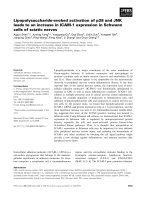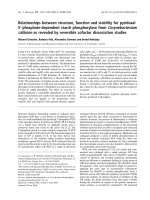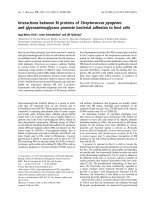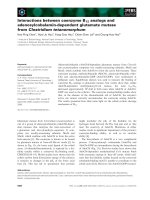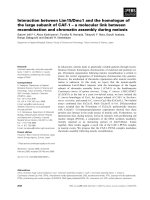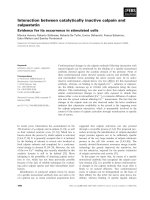Báo cáo khoa học: " Correlation between HIV viral load and aminotransferases as liver damage markers in HIV infected naive patients: a concordance cross-sectional study" pdf
Bạn đang xem bản rút gọn của tài liệu. Xem và tải ngay bản đầy đủ của tài liệu tại đây (210.74 KB, 4 trang )
BioMed Central
Page 1 of 4
(page number not for citation purposes)
Virology Journal
Open Access
Short report
Correlation between HIV viral load and aminotransferases as liver
damage markers in HIV infected naive patients: a concordance
cross-sectional study
José Antonio Mata-Marín*
1
, Jesús Gaytán-Martínez
1
,
Bernardo Horacio Grados-Chavarría
2
, José Luis Fuentes-Allen
1
,
Carla Ileana Arroyo-Anduiza
3
and Alfredo Alfaro-Mejía
2
Address:
1
Infectious diseases department, Hospital de Infectología, "La Raza" National Medical Center, IMSS, Mexico City, México,
2
Internal
medicine department, Hospital de Especialidades, "La Raza" National Medical Center, IMSS, Mexico City, México and
3
Clinical pathology
department, Hospital General, "La Raza" National Medical Center, IMSS, Mexico City, México
Email: José Antonio Mata-Marín* - ; Jesús Gaytán-Martínez - ; Bernardo Horacio Grados-
Chavarría - ; José Luis Fuentes-Allen - ; Carla Ileana Arroyo-
Anduiza - ; Alfredo Alfaro-Mejía -
* Corresponding author
Abstract
Abnormalities in liver function tests could be produced exclusively by direct inflammation in
hepatocytes, caused by the human immunodeficiency virus (HIV). Mechanisms by which HIV causes
hepatic damage are still unknown. Our aim was to determine the correlation between HIV viral
load, and serum levels of aspartate aminotransferase (AST) and alanine aminotransferase (ALT) as
markers of hepatic damage in HIV naive infected patients.
We performed a concordance cross-sectional study. Patients with antiviral treatment experience,
hepatotoxic drugs use or co-infection were excluded. We used a Pearson's correlation coefficient
to calculate the correlation between aminotransferases serum levels with HIV viral load. We
enrolled 59 patients, 50 men and 9 women seen from 2006 to 2008. The mean (± SD) age of our
subjects was 34.24 ± 9.5, AST 37.73 ± 29.94 IU/mL, ALT 43.34 ± 42.41 IU/mL, HIV viral load
199,243 ± 292,905 copies/mL, and CD4+ cells count 361 ± 289 cells/mm3. There was a moderately
strong, positive correlation between AST serum levels and HIV viral load (r = 0.439, P < 0.001);
and a weak correlation between ALT serum levels and HIV viral load (r = 0.276, P = 0.034); after
adjusting the confounders in lineal regression model the correlation remained significant. Our
results suggest that there is an association between HIV viral load and aminotransferases as
markers of hepatic damage; we should improved recognition, diagnosis and potential therapy of
hepatic damage in HIV infected patients.
Published: 30 October 2009
Virology Journal 2009, 6:181 doi:10.1186/1743-422X-6-181
Received: 18 September 2009
Accepted: 30 October 2009
This article is available from: />© 2009 Mata-Marín et al; licensee BioMed Central Ltd.
This is an Open Access article distributed under the terms of the Creative Commons Attribution License ( />),
which permits unrestricted use, distribution, and reproduction in any medium, provided the original work is properly cited.
Virology Journal 2009, 6:181 />Page 2 of 4
(page number not for citation purposes)
Introduction
HIV-AIDS is one of the main causes of mortality over the
world; during the last decade the amount of human
immunodeficiency virus (HIV) infected patients has
increased dramatically worldwide [1-3].
In HIV infected patients, the increase in hepatic enzymes
could be secondary to multiple factors such as alcoholism,
lipid lowering drugs, co-infection with hepatitis viruses,
or hereditary diseases; in addition, it has been proposed
that HIV causes a direct damage over hepatic cells [4-9].
Many factors are associated with hepatic damage: antiret-
roviral treatment, co-infections with hepatitis B or C virus,
opportunistic infections as citomegalovirus, mycobacte-
rium, leishmaniasis, or tumors (lymphoma and Kaposi's
sarcoma), cholangitis associated to parasites (crypt-
osporidiosis and microsporidiosis) and toxicity related
with non antiretroviral drugs (trimetoprim and other anti-
biotics)[10].
Abnormalities in liver function tests could be produced
exclusively by direct inflammation in hepatocytes, caused
by the virus. Mechanisms by which HIV causes hepatic
damage are still unknown, but the most important mech-
anisms could be apoptosis (induced by caspases 2, 7 and
8) and mitochondrial dysfunction with decreasing in
mitochondrial DNA in several tissues; another injury
mechanism is permeability alteration in mitochondrial
membrane by HIV proteins which stimulate an inflamma-
tory response [9-16].
Aspartate aminotransferase (AST) and alanine ami-
notransferase (ALT) are hepatic enzymes that could be
used as markers of hepatocellular injury [17].
The purpose of the study was to determine the correlation
between HIV viral load, with serum levels of AST and ALT
as markers of hepatic damage in HIV naïve infected
patients.
Patients and methods
We performed a concordance cross-sectional study in
which HIV infected naïve patients without opportunistic
or co-infections at the moment of the evaluation were
included. We enrolled patients seen at the Hospital de
Infectología, "La Raza" National Medical Center in Mex-
ico City from January 2006 to September 2008. Patients
with recent diagnosis of HIV were eligible for the study if
they were between the ages of 18 and 65 years old with
negative serology to hepatitis B or C. Patients were
excluded if they had alcohol consumption during the last
three months or had suffered any kind of opportunistic
disease or co-infection.
We ascertained patients' general attributes (age, sex), med-
ical history, risk factors, medications, height, weight, vital
signs, HIV infection confirmed by ELISA and Western-
blot; and the following laboratory tests: blood cells count,
bleeding times, blood chemistry, liver function tests and
CD4+ cells count were obtained. In addition TORCH
panel and VDRL were requested; HIV viral load was meas-
ured using reverse-transcriptase polymerase chain reac-
tion (RT-PCR) test, with a detection limit lower than < 50
copies/ml.
Medical history and physical examination were per-
formed in order to exclude any kind of opportunistic
infection or definitory AIDS disease.
The strength of relationship between HIV viral load and
AST and ALT was estimated by a Pearson correlation coef-
ficient. To adjust for the effects of potential confounders,
we used a linear regression model. The statistical signifi-
cant difference was considered when p-value was less than
0.05.
Results
We enrolled 59 recent diagnosis HIV naïve infected
patients; 84.7% (n = 50) of whom were men; and the
mean (± SD) age was 34.24 ± 9.54 years; regarding sexual
preferences, about men 68% (n = 34) were men who have
sex with men; mean men sexual partners was 17.9 ± 45.4
couples and women 1.8 ± 1.1 couples. Half of male
patients, 25 of 50, had ALT levels 30 IU or more per mil-
liliter at baseline; and most female patients, 6 of 9 had
ALT levels 19 IU/ml or more. Mean HIV viral load was
199,243 ± 292,905 copies/ml and CD4+ cells count 361 ±
289 cells/ml. Mean (± SD) cholesterol was 143.64 ± 31.45
mg/dl and triglycerides was 164.22 ± 94.90 mg/dl. Base-
line characteristics were recorded (Table 1).
Correlation of HIV viral load with AST and ALT
There was a significant moderately strong, positive corre-
lation between HIV viral load and AST (Pearson correla-
tion coefficient = 0.439, P = 0.001) (Figure 1) there was
also a significant mild strong, positive correlation
between HIV viral load and ALT (Pearson correlation coef-
ficient = 0.276, P = 0.034) (Figure 2).
Adjusting for age, cholesterol, triglycerides and CD4+ cells
count in a multivariable linear regression model did not
affect the results. HIV viral load and AST remain signifi-
cant (p = 0.002) either do ALT (p = 0.021)
Discussion
Our results suggest the possibility that in HIV naïve
infected patients, liver injury could be the effect of HIV per
se at least partially. It was found a positive correlation
between HIV viral load and aminotrasferases as liver dam-
Virology Journal 2009, 6:181 />Page 3 of 4
(page number not for citation purposes)
age markers in naïve patients without any kind of oppor-
tunistic diseases or co-infections. There was a stronger
positive correlation between AST and HIV viral load than
with ALT, probably due to other tissues injury (muscle,
lung, and kidney). We explain our results by effect of
apoptosis induced by the viral proteins such as Tat, Nef,
Vpr, protease and gp120 in different cell groups. These
findings support partially the theories of liver damage due
to mitochondrial disturbance and the stimulation of the
caspases cascade in the induction of apoptosis.
These results indicate that clinicians should consider
monitoring aminotransferases levels in all HIV patients
including those without antiretroviral experience. Based
in our results, it is possible that patients with an increase
in aminotransferases could be potentially benefited with
HAART.
There are few studies assessing liver injury associated to
HIV; most of them are basic designs trying to find molec-
ular mechanisms of liver damage [13-15]; other studies
evaluate liver damage induced by the association of hepa-
titis C virus and HIV.
Our findings are consistent with those of Ejilemele et al.,
reporting common abnormalities of liver enzymes in HIV
Table 1: Basal characteristics of 59 HIV naïve infected patients
Variable Minimum Maximum Mean SD
Age (years) 20 61 34.24 9.54
Mass corporal index (kg/m
2
) 17.7 31.45 24.32 4.90
Sexual partners number 1 300 17.92 45.44
Hemoglobin g/dl 8.2 18.2 14.81 1.86
Platelets × 10
-9
/liter 60,100 350,000 215,747 51,851
Leucocytes × 10
-9
/liter 2.2 11 5.59 1.79
Glucose mg/dl 73 115 91.47 9.52
Creatinine mg/dl 0.7 1.4 0.95 0.14
Cholesterol mg/dl 68 220 143.64 31.45
Triglycerides mg/dl 57 450 164.22 91.90
Albumin g/dl 3.2 5.5 4.63 0.54
AST IU/mL 13 158 37.73 29.94
ALT IU/mL 12 276 43.34 43.34
CD4+ cells/mL 9 1495 361.42 289.56
HIV viral load (copies/mL) 500 1,000,000 199,243 292,905
Scatter plot of HIV viral load and ASTFigure 1
Scatter plot of HIV viral load and AST. There is a signif-
icant moderately strong, positive correlation between HIV
viral load and AST (r = 0.439, P = 0.001).
10000008000006000004000002000000
HIV viral load copies/ml
150
125
100
75
50
25
0
AST IU/ml
Scatter plot of HIV viral load and ALTFigure 2
Scatter plot of HIV viral load and ALT. There is a signif-
icant mild strong, positive correlation between HIV viral load
and ALT (r = 0.276, P = 0.034).
10000008000006000004000002000000
HIV viral load copies/ml
300
250
200
150
100
50
0
ALT IU/ml
Virology Journal 2009, 6:181 />Page 4 of 4
(page number not for citation purposes)
patients; however, they only describe patterns of liver
injury and they didn't establish strength of relationship
between HIV viral load and liver enzymes [18].
Most studies that evaluate liver steatosis include patients
infected with HCV genotype 3; this genotype has been
associated to liver steatosis [19,20].
Sulkowski et al., examined liver tissue from 112 antiretro-
viral experienced HIV-HCV co-infected patients; 60% had
no evidence of histologic liver steatosis, and only 18%
had steatosis with more than 5% hepatocytes affected, but
they didn't evaluate HIV mono-infected naïve patients
[20].
Unfortunately the sample we studied was small; and that
increases the possibility of a higher random error. Another
limitation is the cross-section design which is unable to
measure all potential confounders; however, in analysis,
confounding factors were controlled; then, we consider
results are valid for our population.
According to our results there is a correlation between the
HIV viral load, and aminotransferases serum levels in HIV
infected naïve patients. Liver function tests should be
monitorized closely in these patients; and we suggest eval-
uating early start of antiretroviral treatment in HIV
infected patients with severe liver damage regardless of
CD4+ cell count.
It is necessary to perform a study including more patients,
using direct or indirect liver damage measures (biopsy,
fibrotest or transient elastography) to improve recogni-
tion, diagnosis and management. Finally, future prospec-
tive research to study antiretroviral therapy effects on
reducing aminotransferases levels in these patients should
be developed.
Competing interests
The authors declare that they have no competing interests.
Authors' contributions
JAMM, JGM and BHGC performed the majority of experi-
ments. All the authors provided the collection of all the
human material in addition to providing financial sup-
port for this work; JAMM gave the analytic tools to this
paper. JAMM, JLFA, JGM, AAM and CIAA provided vital
reagents and were also involved in editing the manuscript.
JAMM designed the study and all the authors wrote and
approved the final manuscript.
Acknowledgements
The authors wish to acknowledge to the study participants and who con-
tributed to this study.
References
1. Fauci AS: Twenty-five years of HIV/AIDS. Science 2006, 313:409.
2. Blacker J: The impact of AIDS on adult mortality: evidence
from national and regional statistics. AIDS 2004, 18(supl
2):S19-S26.
3. UNAIDS: 2006 AIDS Epidemic update: Geneva (Seitzer-
land): Joint United Nations Programme on HIV/AIDS,
November 2006 [
]
4. Jain MK: Drug-induced liver injury associated with HIV medi-
cations. Clin Liver Dis 2007, 11:615-39.
5. Walker UA: Antiretroviral therapy induced liver alterations.
Curr Opin HIV AIDS 2007, 2:293-8.
6. Vogel M, Rockstroh J: Hepatotoxicity and liver disease in the
context of HIV therapy. Curr Opin HIV AIDS 2007, 2:306-13.
7. Mocroft A, Phillips AN, Soriano V, Ledergerber B, Kirk O, Vinogra-
dova E, Reiss P, Katlama C, Phillips AN, Lundgren JD, EuroSIDA Study
Group: Reasons for stopping antiretroviral regimen:
Increased incidente of stopping due to toxicity or patient/
physician choice in patients with hepatitis C coinfection.
AIDS Res Hum Retroviruses 2005, 21:743-52.
8. Cooper Curtis L: HIV antiretroviral medications and hepato-
toxicity. Curr Opin HIV AIDS 2007, 2:466-73.
9. Pol S, Lebray P, Vallet-Pichard A: HIV infection and hepatic
enzyme abnormalities: intricacies of the pathogenic mecha-
nisms. Clin Infect Dis 2004, 38(suppl 2):S65-S72.
10. Cote HC, Brumme ZL, Craib KJ, Alexander CS, Wynhoven B, Ting L,
Wong H, Harris M, Harrigan PR, O'Shaughnessy MV, Montaner JS:
Changes in mitocondrial DNA as a marker of nucleoside tox-
icity in HIV-infected patients. N Engl J Med 2002, 346:811-20.
11. Miro O, López S, Martínez E, Pedrol E, Milinkovic A, Deig E, Garrabou
G, Casademont J, Gatell JM, Cardellach F: Mitochondrial effects of
HIV infection on the peripheral blood mononuclear cells of
HIV-infected patients who were never treated with antiret-
rovirals. Clin Infect Dis 2004, 39:710-6.
12. Casula M, Bosboom-Dobbelaer I, Smolders K, Otto S, Bakker M, de
Baar MP, Reiss P, de Ronde A: Infection with HIV-1 induces a
decrease in mt-DNA. J Infect Dis 2005, 191:1468-71.
13. Jacotot E, Ravagnan L, Loeffler M, Ferri KF, Vieira HL, Zamzami N,
Costantini P, Druillennec S, Hoebeke J, Briand JP, Irinopoulou T, Dau-
gas E, Susin SA, Cointe D, Xie ZH, Reed JC, Roques BP, Kroemer G:
The HIV-1 viral protein R induces apoptosis via a direct
effect on the mitochondrial permeability transition pore.
J
Exp Med 2000, 191:33-46.
14. Balasubramanian A, Koziel M, Groopman JE, Ganju RK: Molecular
mechanism of hepatic injury in coinfection with hepatitis C
virus and HIV. Clin Infect Dis 2005, 41(Supl 1):S32-S37.
15. Gross A, Jockel J, Wei MC, Korsmeyer SJ: Enforced dimerization
of Bax results in its translocation, mitochondrial dysfunction
and apoptosis. EMBO J 1998, 17:3878-85.
16. Guaraldi G, Squillace N, Stentarelli C, Orlando G, D'Amico R, Ligabue
G, Fiocchi F, Zona S, Loria P, Esposito R, Palella F: Nonalcoholic
fatty liver disease in HIV infected-patients referred to a met-
abolic clinic: prevalence, characteristics, and predictors. Clin
Infect Dis 2008, 47:250-7.
17. Zechini B, Pasquazzi Z, Aceti A: Correlation of serum ami-
notransferases with HCV RNA levels and histological find-
ings in patients with chronic hepatitis C: the role of serum
aspartate transaminase in the evaluation of disease progres-
sion. Eur J Gastroenterol Hepatol 2004, 16:891-6.
18. Ejilemele AA, Nwauche Ca, Ejele OA: Pattern of abnormal liver
enzymes in HIV patients presenting al a Nigerian Tertiary
Hospital. Níger Postgrad Med J 2007, 14:306-9.
19. Bruno R, Sacchi P, Puoti M, Maiocchi L, Patruno SF, Cima S, Filice G:
Pathogenesis of liver damage in HCV-HIV patients. AIDS Rev
2008, 10:15-24.
20. Sulkowski M, Mehta S, Torbenson M, Afdhal NH, Mirel L, Moore RD,
Thomas DL: Hepatic steatosis and antiretroviral drug use
among adults coinfected with HIV and hepatitis C virus. AIDS
2005, 19:585-92.


